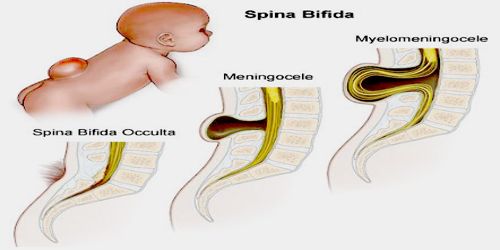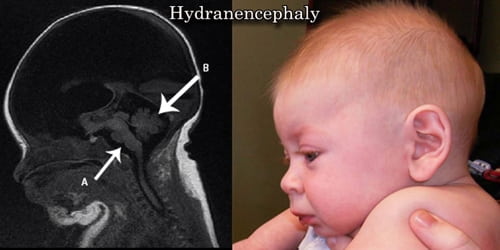Spina Bifida
Definition
Spina bifida is a congenital defect caused by incomplete formation of the neural tube, in which the vertebral column is not fully closed, resulting in protrusion of the meninges and sometimes the spinal cord. Damage to the exposed spinal cord can cause neurological abnormalites, including paralysis.

Spania bifida actually means ‘split spine’ in Latin, and it is the name for the most common birth defect that causes permanent disability. It is a neural tube defect, which refers to defects of the spine, spinal cord or the brain. Spina bifida develops in the womb and occurs when the spinal column fails to close all the way. The exact cause for it is unknown, but there are three main types of spina bifida: spina bifida occulta, meningocele, and myelomeningocele.
About 5% of people have spina bifida occulta. Rates of other types of spina bifida vary significantly by country, from 0.1 to 5 per 1000 births. On average in developed countries it occurs in about 0.4 per 1000 births. In the United States, it affected about 0.4 per 1000 births, and in India, about 1.9 per 1000 births. Part of this difference is believed to be due to race – with Caucasians at higher risk – and partly due to environmental factors.
People with spina bifida often have neurological deficits below the level of the lesion and can suffer from bladder and bowel incontinence, limited mobility (due to paralysis of the legs), and learning problems. The risk of spina bifida varies according to country, ethnic group, and socioeconomic status. The risk of spina bifida and other neural tube defects, such as anencephaly, can be significantly decreased if women take ample folic acid before conception and during pregnancy.
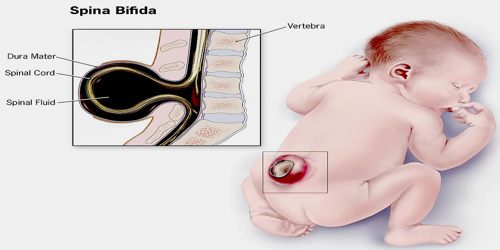
Causes, Sign and Symptoms of Spania Bifida
The exact cause of this birth defect isn’t known. Experts think that genes and the environment are part of the cause. A folic acid deficiency during pregnancy also plays a significant role. Other risk factors include certain antiseizure medications, obesity, and poorly managed diabetes. Drinking alcohol often triggers macrocytosis which discard folate. After stopping the drinking of alcohol, a time period of months is needed to rejuvenate bone marrow and recover from the macrocytosis.
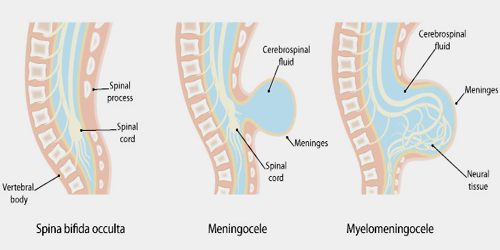
Drugs such as valproate, used to treat epilepsy or bipolar disorder, have been associated with a higher risk of giving birth to babies with congenital defects, such as spina bifida. A woman who has diabetes is more likely to have a baby with spina bifida, than one who does not. A woman whose body mass index (BMI) is 30 or above has a higher risk of having a baby with spina bifida.
The symptoms of spina bifida vary depending on the type and severity of the birth defect. Babies born with spina bifida occulta may have no symptoms at all. In some cases, though, this type of defect can cause an abnormal appearance on the back where the spine is split. In many cases, children with meningocele don’t have any symptoms.
- Children with the most severe form of spina bifida often have spine and brain issues that cause serious problems. They may have:
- Little or no feeling in their legs, feet, or arms, so they may not be able to move those parts of the body.
- Bladder or bowel problems, such as leaking urine or having a hard time passing stools.
- Fluid buildup in the brain (hydrocephalus). Even when it is treated, this may cause seizures, learning problems, or vision problems.
- A curve in their spine, such as scoliosis.
Individuals with spina bifida tend to have better reading skills than mathematics skills. Children and adults with spina bifida have stronger abilities in reading accuracy than in reading comprehension.
Most patients have some degree of paralysis in their legs. In cases of partial paralysis, leg braces or a walking stick may be necessary. A person with total paralysis will need a wheelchair. If the lower limbs are not exercised, they can become weak, leading to dislocated joints and misshapen bones. In time, the individual may experience skin problems, gastrointestinal problems, latex allergies, and depression.
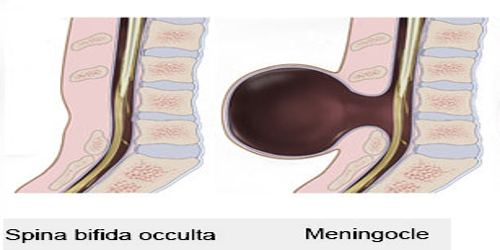
Other types of Spina Bifida –
- Spina bifida occulta: This is the mildest form. Most patients have no neurological signs or symptoms. There may be a small birthmark, dimple or tuft of hair on the skin where the spinal defect is. The person may never know they have spina bifida, unless a test for another condition reveals it by chance.
- Meningocele: The spinal cord develops normally, but the meninges, or protective membranes around the spinal cord, push through the opening in the vertebrae. The membranes are surgically removed, usually with little or no damage to nerve pathways.
Diagnosis, Treatment and Prventions of Spania Bifida
During pregnancy, woman can have a blood test (maternal serum triple or quadruple screen) and an ultrasound of the developing baby. These tests check for signs of spina bifida and other problems. If spina bifida is suspected, the doctor may do an X-ray, an MRI, or a CT scan to see if the defect is mild or severe.
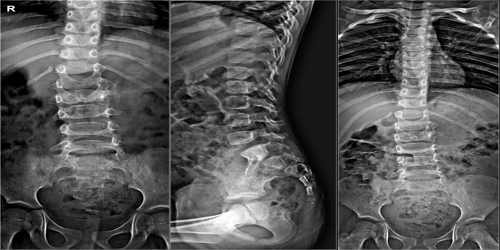
There is no known cure for nerve damage caused by spina bifida. Standard treatment is surgery after delivery.
- Surgery to repair the spine: This can be done within 2 days of birth. The surgeon replaces the spinal cord and any exposed tissues or nerves back into the newborn’s body. The gap in the vertebrae is then closed and the spinal cord sealed with muscle and skin.
- Prenatal surgery: The surgeon opens the uterus and repairs the spinal cord of the fetus, usually during week 19 to 25 of pregnancy. This type of surgery may be recommended to reduce the risk of spina bifida worsening after delivery.
- Cesarian-section birth: If spina bifida is present in the fetus, delivery will probably be by cesarean section. This is safer for the exposed nerves.
- Hydrocephalus: Surgery can treat a buildup of cerebrospinal fluid in the brain. The surgeon implants a thin tube, or shunt, in the baby’s brain. The shunt drains away excess fluid, usually to the abdomen. A permanent shunt is usually necessary.
- Physical therapy: This is vital, as it helps the individual become more independent and prevents the lower limb muscles from weakening. Special leg braces may help keep the muscles strong.
- Assistive technologies: A patient with total paralysis of the legs will need a wheelchair. Electric wheelchairs are convenient, but manual ones help maintain upper-body strength and general fitness.
- Occupational therapy: This can help the child perform everyday activities more effectively, such as getting dressed. It can encourage self-esteem and independence.

Before and during pregnancy, a woman can help prevent spina bifida in her child. Get plenty of folic acid each day, both before you get pregnant and during pregnancy. Foods rich in folic acid include fortified breakfast cereals and breads, spinach, and oranges.
Folate fortification of enriched grain products has been mandatory in the United States since 1998. The U.S. Food and Drug Administration, Public Health Agency of Canada and UK recommended amount of folic acid for women of childbearing age and women planning to become pregnant is at least 0.4 mg/day of folic acid from at least three months before conception, and continued for the first 12 weeks of pregnancy. Women who have already had a baby with spina bifida or other type of neural tube defect, or are taking anticonvulsant medication, should take a higher dose of 4–5 mg/day.
Reference:
